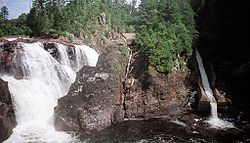- Chute (gravity)
-
For other uses, see Chute (disambiguation).Natural chute (falls) on the left and man-made logging chute on the right on the Coulonge River in Quebec, Canada.

A chute is a vertical or inclined plane, channel, or passage through which objects are moved by means of gravity.
Contents
Landform
A chute, also known as a race, flume, or river canyon, is a steep-sided passage through which water flows rapidly.
Akin to these, man-made chutes, such as the timber slide and log flume, were used in the logging industry to facilitate the downstream transportation of timber along rivers. These are no longer in common use. Man-made chutes may also be a feature of spillways on some dams. Some types of water supply and irrigation systems are gravity fed, hence chutes. These include aqueducts and acequias.
Building chute
Chutes are in common use in tall buildings to allow the rapid transport of items from the upper floors to a central location on one of the lower floors or basement. Chutes may be round, square or rectangular at the top and/or the bottom.
- Laundry chutes in hotels are placed on each floor to allow the expedient transfer and collection of dirty laundry to the hotel's laundry facility without having to use elevators or stairs. In popular culture stories, laundry chutes are commonly used as means for the protagonist to quickly escape, the laundry at the chute's base often serving to cushion the hero's fall. These chutes are generally aluminized steel and welded together to avoid any extruding parts that may rip or damage the materials.
- Home laundry chutes are placed on each floor of multistory homes allow the collection of all household members' dirty laundry to one location, conveniently next to the laundry facilities, without the constant transport of laundry bins from story-to-story or room-to-room or up and down stairs. Home laundry chutes may be less common than previously due to building codes or concern regarding fireblocking, the prevention of fire from spreading from floor-to-floor,[1] as well as child safety.[2][3] However, construction including cabinets, doors, lids, and locks may make both risks significantly less than with simple stairwells.
- Garbage chutes are common in high-rise apartment buildings and are used to collect all the building's garbage in the one place. Often the bottom end of the chute is placed directly above a large waste receptacle. This makes garbage collection more efficient. However, it must be noted that over the last 10-15 years, the nature of our waste and consequently waste management has changed significantly. These changes (i.e. shortage of landfills, composting of organic waste, segregation of recyclable materials – plastic, paper, glass etc., de-centralised handling of waste) have put those living in apartments with garbage chutes at an unfair disadvantage, due to the absence of tools that facilitate segregation at source. Many cities have found that the use of garbage chutes is emerging as one of the barriers to segregation of waste, resulting in indiscriminate pressure on landfills.
- Mail chutes are used in some buildings to collect the occupants' mail. A notable example is the Asia Insurance Building.
- Escape chutes are used and proposed for use in evacuation of mining equipment and high-rise buildings.[4][5]
- Construction chutes are used to remove rubble and similar demolition materials safely from taller buildings. These temporary structures typically consist of a chain of cylindrical or conical plastic tubes, each fitted into the top of the one below and tied together, usually with chains. Together they form a long flexible tube, which is hung down the side of the building. The lower end of this tube is placed over a skip or other receptacle, and waste materials are dropped into the top. Heavy duty steel chutes may also be used when the debris being deposited is heavy duty and in cases of particularly high buildings.
An elevator is not a chute since it does not operate by means of gravity.
Chutes in transportation
Goust, a hamlet in southwestern France, is notable for its mountainside chute that is used to transport coffins.
Chutes are also found in:
References
- ^ Dru Sefton, Sunday, January 23, 2005. .
- ^ "Laundry Chutes - a Convenient Way to a … Disaster", Check This House, Inc..
- ^ January 21, 2009. "Laundry Chutes: Pros & Cons", One Project Closer.
- ^ "Ingstrom Escape Chute - Building Evacuation Chute". Ingstromescapechute.com.au. http://www.ingstromescapechute.com.au. Retrieved 2008-11-05.
- ^ "Baker Life Chute - Rapid, Mass Evacuation from High Rise Structures during Life Threatening Emergencies". Lifechute.com. http://www.lifechute.com/index2.html. Retrieved 2008-11-05.
Categories:- Building engineering
- Landforms
Wikimedia Foundation. 2010.




